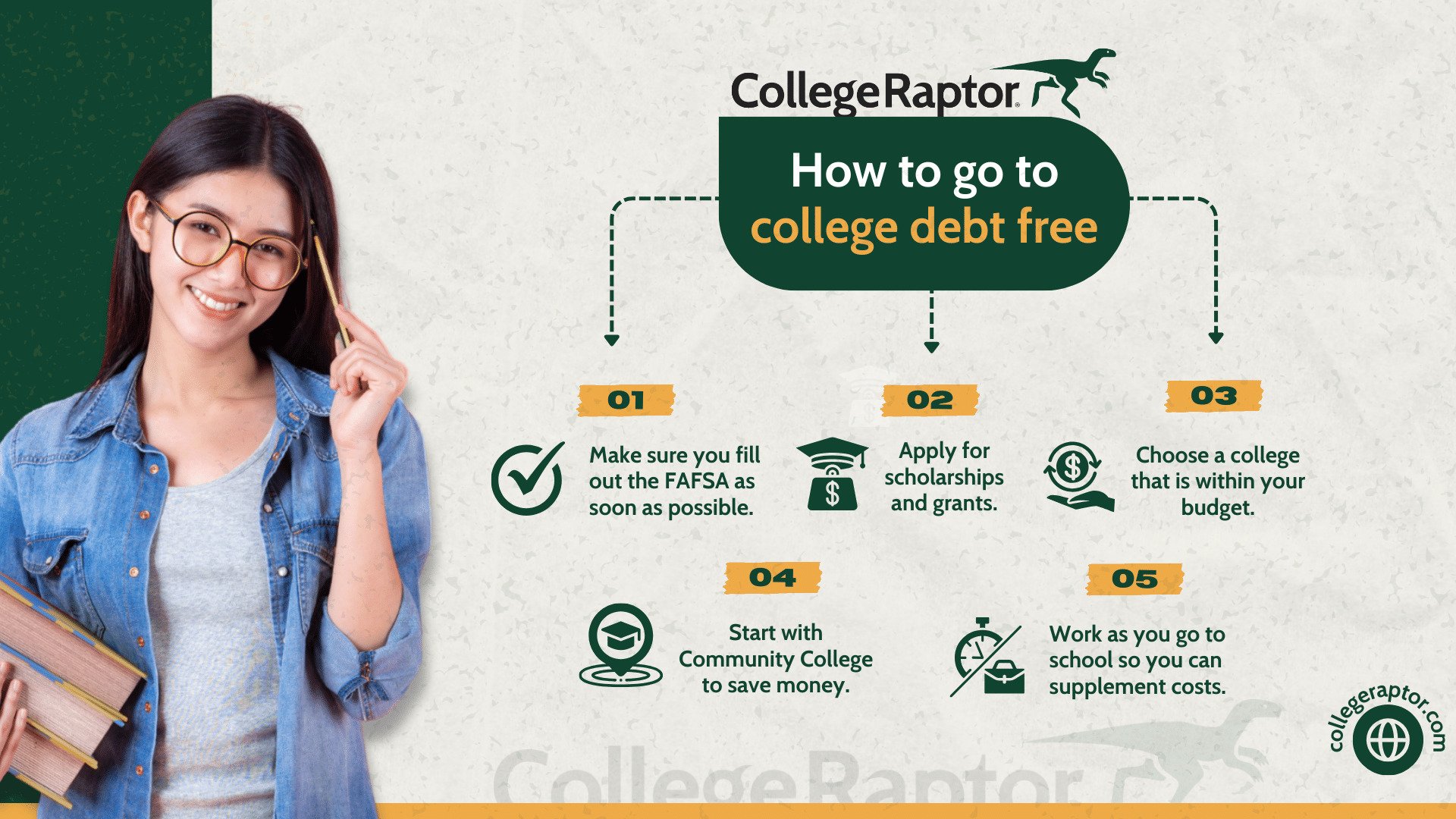No one wants to graduate college under a mountain of student loan debt that needs to be repaid. And as a result, some students are actually forgoing the college experience all together in order to save their future finances. While sometimes it is unavoidable if you want to go to a particular college or study a specific major, there are ways students can graduate debt free – or at least with less debt. Here are some strategies you’ll want to employ if you want to keep down your college costs and have less to repay after you leave school.
1. Complete your FAFSA as Soon as Possible
One of the most important things you should do if you want to graduate college with minimal or no debt is to first complete your Free Application for Federal Student Aid (FAFSA) every single year. This application allows you to see if you are eligible for certain federal student aid programs such as the Pell Grant. Contrary to popular belief, it’s not just about federal loans.
And it’s not just about the federal government helping you out either. Colleges and universities tend to have endowment programs that help make education more affordable for students with demonstrated financial need. And did you know that these schools will often use the FAFSA to determine who qualifies for their programs? By skipping the FAFSA, you could be skipping some serious cash and possibly even a full ride to your dream school.
Why Is Timing Important?
The FAFSA usually becomes available on October 1st of each year (December for 2023), and it’s important to complete it as soon as possible. Although the deadline is not actually until the end of the award year (so a FAFSA that was released in October 2022 for the 2023-24 academic year does not technically have to be turned in until June 2024), you’re doing yourself a disservice by waiting or delaying. Colleges and universities have their own FAFSA deadlines, and their endowment programs will run out of cash as they’re first come first served. Pell Grants can also run out. Waiting could mean you’re only eligible for federal student aid loans, which doesn’t help you graduate debt free.
If you qualify for any programs through the government or your school, you will receive an award letter when you receive your college acceptance letter.
In addition, the FAFSA is also often used to qualify for state grants and even some scholarships. These programs tend to require the application or a similar state application if you want to be in the running for these awards.

2. Apply for Scholarships and Grants
Scholarships are literally free money for you to attend school. There are awards out there for everything, too, from choice of major to ancestry to hair color. You only need to find them – and apply to them. Scholarship databases, such as College Raptor’s Scholarship Search Tool, make it easy to identify awards you qualify for and apply to them with less hassle.
Grants can also be an excellent way to graduate from college debt free. In most cases, like scholarships, these awards do not have to be repaid. However, there are some that have requirements. For example, some state grants for future teachers require the college graduate to teach within the state for a certain number of years. If the individual fails to meet that requirement, some or all of the grant will have to be repaid.
Create a schedule and calendar to apply for scholarships and grants so you can be sure you’re not missing any important deadlines.
3. Go to a College You Can Afford
College is expensive. There’s no getting around that. But many schools are less expensive than others. If you want to graduate with little to no debt, you’re going to want to consider going to a less expensive school. Now, less costly doesn’t automatically mean less of an education or value. Colleges and universities charge different amounts for different reasons – and you can get an amazing education at a number of “less expensive” schools.
When you receive your acceptance and award letters in the spring, be sure to compare your options. You might discover that while School A offered you less in financial aid than School B, School A’s package covers much more of the tuition than School B. Financial aid award letters can get confusing, too, so if you’re struggling to make sense of them, be sure to use a Financial Aid Offer Comparison Tool to set the story straight.
Being realistic about your financial situation and goals can also help you make the best decision for your wallet, today and in the future.
4. Consider Attending Community College First
Did you know that most of the first two years of college are spent on general education requirements? While you can take a few major related classes here and there during your first and sophomore years, you really don’t start getting into those classes until you’re a junior.
Community college, therefore, is a great alternative to going to a four-year college for all four years. You can spend your first two years at the community college, complete your general education classes, and then transfer to a 4 year to get your bachelor’s. This can potentially save you thousands and thousands of dollars.
You do want to be sure though that your community college credits will transfer to the university, though. You can reach out to potential colleges’ admissions departments to see if it would work for you.
5. Go to a Local School
Many colleges and universities have in-state tuition rates for their students. This means, if you’re from the college’s state, you’ll pay less in tuition than someone who is from another state. Some states also have what is known as tuition reciprocity. In these cases, out-of-state students from certain locations can qualify for in-state tuition, but these are usually restricted to specific regions.
In addition, students can also save money by going to a local school because they can potentially live with their parents. Room and board or renting an apartment can be extremely expensive. But by staying home and commuting, living costs can be cut down by quite a bit.
6. Get a Head Start on College
Who says you have to wait until you’re a high school graduate to go to college? You can in fact get a head start before you wear your cap and gown! Many high schools offer college programs through their local community college or have AP classes. If you pass these courses with high enough grades, they could transfer to your future college. This allows you to take fewer classes during college, saving you big time on credit costs.
Colleges also sometimes offer placement tests for certain studies, such as math or language. If you do well enough on these tests, you could be allowed to skip certain courses or even gain credit for them without ever stepping foot in the classroom.
7. Work
Another option you have to graduate college debt free is to get a job. Whether you’re working all year round or just during the summer, the money will add up and can help make a dent in your expenses. Businesses in college towns understand you have finals and classes, so they’ll often work with you to develop a schedule that works for you both.
And, if you completed your FAFSA, you might have qualified for a work-study program. This is where you can work on the college campus and earn money that can then be put towards expenses.
8. Graduate Faster
Although it generally takes four years to get your bachelor’s degree, that is not a hard and fast rule. Some students can do it much faster. And getting your degree sooner rather than later not only saves you money on tuition – you’ll save a lot of money on room and board and be able to enter the workforce a lot faster.
Some ways you can graduate faster include taking as many college classes as you can during high school, taking summer and winter courses, and loading up your fall and spring semesters. This can be a lot of work and pressure though, so be sure to plan ahead if you’re thinking about taking this route.
9. Be Smart with Your Money
College tuition is one of your biggest college expenses. But it’s definitely not your only cost. From food to books, there’s a lot to cover. However, there are ways to save money throughout the four years and that cash will add up. Save enough, and you can make a pretty big dent in that debt.
Here are some tips:
- Buy used books and supplies where possible. You can also compare book and supply costs from different sources before buying.
- Compare food plan options and costs on campus. You might find that one meal plan is significantly cheaper than the other.
- Keep your student ID with you. Many businesses and museums offer discounts to students.
- Think about your housing. Is it cheaper to rent an apartment, have roommates in a house, or get a dorm room in your college town?
- Don’t bring a car unless necessary. Many college towns have public transportation, and you don’t necessarily need this extra expense.
- Limit your spending. Have some fun spending money but limit how much you eat out or spend on entertainment.
How much debt you graduate with really depends on the school you attend, how much money your family and you have saved up, the scholarships and grants you receive, and other choices during your four years of college. But utilizing these tips can help you make graduating debt free from college more of a reality.
Scholarships are a great way to work towards paying down college costs. Using our Scholarship Search Tool, you can quickly identify, save, and apply to a variety of different awards you qualify for. And it’s free! Get started today.
| Lender | Rates (APR) | Eligibility | |
|---|---|---|---|
 |
5.34%-15.96%* Variable
3.99%-15.61%* Fixed
|
Undergraduate and Graduate
|
VISIT CITIZENS |
 |
4.92% - 15.08% Variable
3.99% - 15.49% Fixed
|
Undergraduate and Graduate
|
VISIT SALLIE MAE |
 |
4.50% - 17.99% Variable
3.49% - 17.99% Fixed
|
Undergraduate and Graduate
|
VISIT CREDIBLE |
 |
6.00% - 13.75% Variable
3.99% - 13.75% Fixed
|
Undergraduate and Graduate
|
VISIT LENDKEY |
 |
5.50% - 14.56% Variable
3.69% - 14.41% Fixed
|
Undergraduate and Graduate
|
VISIT ASCENT |
 |
3.70% - 8.75% Fixed
|
Undergraduate and Graduate
|
VISIT ISL |
 |
4.99% - 16.85% Variable
3.47% - 16.49% Fixed
|
Undergraduate and Graduate
|
VISIT EARNEST |
 |
5.00% - 14.22% Variable
3.69% - 14.22% Fixed
|
Undergraduate and Graduate
|
VISIT ELFI |






